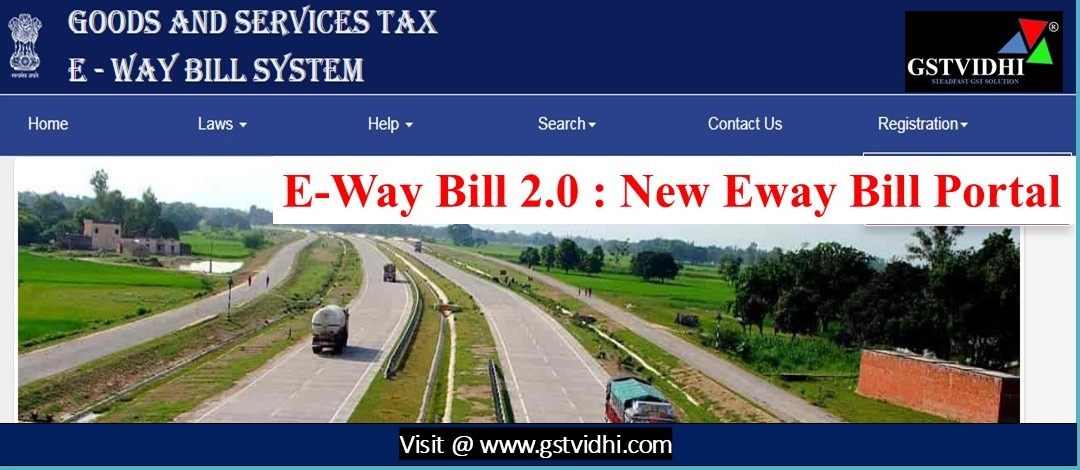
E-Way Bill 2.0: Introduction of Enhanced Inter-Operable Services
Between E-Way Bill Portals
Introduction: To
make the E-Way Bill system more reliable and user-friendly, the GST Network
(GSTN) has announced the launch of a new portal called E-Way Bill 2.0
(available at https://ewaybill2.gst.gov.in). This new portal will start
functioning from 1st July 2025 and will work alongside the existing
E-Way Bill 1.0 portal (available at https://ewaybillgst.gov.in).
The main goal is to provide
smooth and uninterrupted services to taxpayers and transporters, especially
during technical issues or downtime on one of the portals. The two portals will
now support cross-portal operations, which means a task started on one
portal can be continued or completed on the other.
1. Purpose
of Launching E-Way Bill 2.0
The government received
many suggestions from businesses and transporters requesting a backup system
to avoid problems when the main E-Way Bill portal is down or not working
properly. To solve this issue, the new E-Way Bill 2.0 portal has been
created.
It is designed to:
- Work interchangeably with the
existing portal.
- Allow users to continue their work on
either portal.
- Help in business continuity so
that there are no delays in transport due to portal issues.
- Reduce dependency
on just one system.
2. New
Services Now Available on E-Way Bill 2.0 (for Bills from Both Portals)
Whether an E-Way Bill was
generated on the old portal (1.0) or new portal (2.0), the following services
can now be used on either one:
Newly Added
Inter-Operable Features:
- Create an E-Way Bill using Part-A
details (shared by the supplier).
- Create a Consolidated E-Way Bill
(for multiple consignments in one vehicle).
- Extend the validity
of an existing E-Way Bill (e.g., if the journey is delayed).
- Update transporter details
(change or assign a new transporter).
- Retrieve consolidated E-Way Bills
easily.
Already Available
Features (Now Fully Cross-Compatible):
- Generate new E-Way Bills.
- Update vehicle numbers (Part-B).
- Print E-Way Bills.
This means if you started
a bill on the 1.0 portal, you can still update or print it using the 2.0 portal
— and vice versa.
3. How Both
Portals Work Together – Real-Time Sync
The two portals will work
on a real-time synchronisation system, meaning that any change made on
one portal will reflect on the other within a few seconds.
Important Points:
- If the E-Way Bill 1.0 portal is
down, you can switch to the E-Way Bill 2.0 portal and continue
your work like updating Part-B or printing slips.
- Both portals share data instantly, so
there's no duplication or mismatch.
- E-Way Bill slips from either portal
are legally valid and accepted.
- This new system ensures that
transport is not delayed and goods movement continues without hassle.
4.
Availability Through APIs (For System Integration)
In addition to using the
web portal, businesses and transporters can now access all these services
through APIs (Application Programming Interfaces). This is especially
useful for:
- Large taxpayers,
- Transporters,
- Logistics operators, and
- Companies using ERP software
or automated systems.
These APIs are currently
available in a sandbox testing environment, where businesses can test
and integrate them before using them in real-time.
By using APIs, businesses
can:
- Generate or update E-Way Bills
automatically from their software,
- Save time and reduce manual errors,
- Improve operational speed.
5. Key
Benefits of the New Dual Portal System
The E-Way Bill 2.0 portal
provides several important benefits:
No More Downtime Worries
If one portal is down due
to maintenance or technical issues, you can continue your work from the second
portal.
Easy Cross-Portal Use
All major services like
vehicle updates, bill printing, and validity extensions can now be done from
either portal, regardless of where the bill was first created.
Fast Sync
Any updates are reflected
across both portals instantly, within a few seconds.
Smooth Transport
Operations
Helps avoid delays in
transportation due to portal unavailability. You can carry E-Way Bill slips
generated from either portal — both are accepted during checks.
Better Automation
Businesses can now
integrate their systems using the newly available APIs for faster and more
accurate operations.
6. What
Taxpayers and Transporters Should Do Now
Here are some simple
steps to follow:
- Visit the new portal
at (https://ewaybill2.gst.gov.in)and explore the interface.
- Try out the new features,
like updating Part-B or generating consolidated E-Way Bills.
- Inform your transporters
and staff about the new system.
- If you use ERP or billing software,
ask your developer to integrate the new API services.
- Refer to the user manuals and
help guides provided on the portal.
- For any doubts, call or email the GST
Helpdesk.
Author’s Comment
The launch of E-Way
Bill 2.0 with cross-portal access and real-time integration is a big step
forward for the GST system. It will reduce downtime-related issues, ensure
smooth movement of goods, and offer businesses more control and flexibility.
Taxpayers are encouraged
to start using the new portal from 1st July 2025 and make the most of
these enhanced features.
Disclaimer: All the Information is based on the notification, circular advisory and order issued by the Govt. authority and judgement delivered by the court or the authority information is strictly for educational purposes and on the basis of our best understanding of laws & not binding on anyone.
Click here